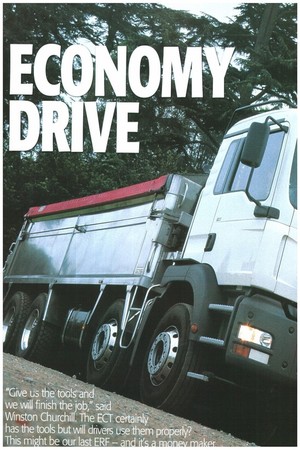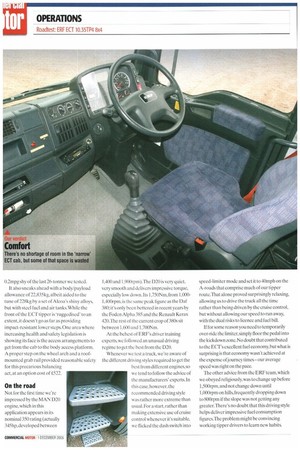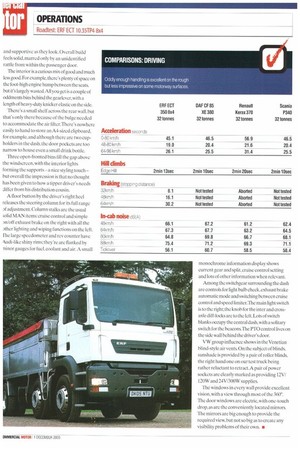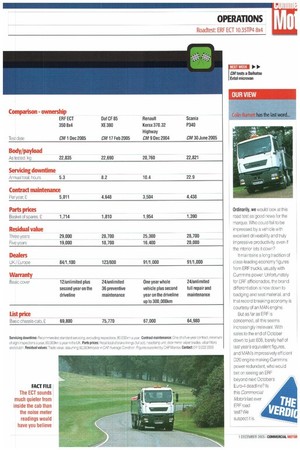"Give us the tools and we will finish the job,"
Page 40

Page 41

Page 42

Page 43

Page 44

Page 47

If you've noticed an error in this article please click here to report it so we can fix it.
said Winston Churchill. The ECT certainly has the tools but will drivers use them properly? This mi ht be our last ERF — and • '
It's fair to say that ERF's ECT is the least ERF product in the brand's seven-decade history. Today it's just an MAN TGA with ERF badges. and even they tragically lost their red, white and blue theme a couple of years back.The cab is effectively the TGA's smallest narrow, lowroof, slight ly extended day cab. in recent years ERFs unique selling point has been its choice of proprietary engines from Cummins and Caterpillar, but today it has MAN's D20 engine. Does that make it a had truck'? Certainly not. But equally, it certainly doesn't make it an ERF.
Buying an ECT 8x4 tipper is a process burdened with relatively few decisions. Overall axle spreads of 6,400 or 6,700mm.and engines with nominal ratings of 350 and 430 metric horses are the only big choices. Suspension is all steel with individual parabolic springs on the front axles, and a pair of inverted parabolics supporting the single-reduction rear bogie. Brakes are electronically controlled discs all round, although huh-reduction axles with drums are an option. Other major options are standard and high-roof sleeper cabs and a "Tipmatic" ZF AS`Ironic automated transmission.
Typically for a product from Germany. where running over plated weight hut within the design weight is apparently punished with a stern telling off. the design GVW is 34,000kg.
Our example came with a nice shiny Wilcox Wilkolite Smooth insulated aluminium body of 16m-' capacity.A Dawbarn cab-controlled electrohydraulic sheeting system keeps the contents in. while an Edhro C.X15 front-end ram gets them out.
Productivity lf,as certain truck PR men believe, the first thing that you. dear reader. look for is the overall fuel figure, you'll already know that the ECT has produced an excellent result.This is the first 32tonner of recent years to crack 9mpg; in fact it's just 0.2mpg shy of the last 26-tormer we tested.
it also sneaks ahead with a body/payload allowance of 22,835kg, albeit aided to the tune of 228kg by a set of Alcoa's shiny alloys, but with steel fuel and air tanks.Whilc the front of the ECT tipper is `ruggedisedto an extent, it doesn't go as far as providing impact-resistant lower steps. One area where increasing health and safety legislation is showing its face is the access arrangements to get from the cab to the body access platform. A proper step on the wheel arch and a roofmounted grab rail provided reasonable safe: for this precarious balancing
act, at an option cost of £522.
On the road
Not for the first time we're impressed by the MAN D20 engine, which in this application appears in its nominal 350 rating (actually 345hp, developed between
1,4(X) and 1,90Orpm).The D20 is very quiet. very smooth and delivers impressive torque, especially low down. Its 1.750Nnt from 1.0001,4()Orpm, is the same peak figure as the Daf 380; it's only been bettered in recent years by the Foden Alpha 385 and the Renault Kerax 420. The rest of the current crop of 380s sit between 1,600 and 1,700Nm.
At the behest of E RF's driver training experts. we followed an unusual driving regime to get the best from the 1320.
Whenever we test a truck, we're aware of the different driving styles required to get the hest from different engines. so we tend to follow the advice of the manufacturers' experts. In this case, however, the recommended driving style was rather more extreme than usual. For a start, rather than making extensive use of cruise control whenever it's suitable. we flicked the dash switch into speed-limiter mode and set it to 40mph on the A-roads that comprise much of our tipper routerlbat alone proved surprisingly relaxing, allowing us to drive the truck all the time rather than being driven by the cruise control, but without allowing our speed to run away, with the dual risks to licence and fuel bill.
If for some reason you need to temporarily over-ride the limiter, simply floor the pedal into the kickdown zone. No doubt that contributed to the [CT's excellent fuel economy, but what is surprising is that economy wasn't achieved at the expense ofjourney times—our average speed was right on the pace.
The other advice from the .ERF team, which we obeyed religiously, was to change up before 1,500-rpm. and not change down until 1,00Orpm on hills, frequently dropping down to 8011rpm if the slope was not getting any greater.There's no doubt that this driving style helps deliver impressive fuel consumption ligures.The problem might he convincing working tipper drivers to learn new habits, The ZF 16-speed gearbox has a traditional H-pattern shift with a rocker switch on the front for the range-change and a splitter toggle on the thumb side.The lever is well located: the gate's widely spaced between the two major planes but clearly defined. However, the park brake lever would be more conveniently located on the dashboard.
The 3,70:1 final drive ratio, combined with a 0.84:1 overdrive top , means 56mph equates to a leisurely 1.35Orpm with the A-road limit needing just 1,(XX)rpm. where it plods along quite happily. Considering the lazy nature of the engine, the ERF is surprisingly harsh on the noise meter (more so than on the ear. as it sounds much quieter than the figures indicate). Only at maximum cruising speed does wind noise make a significant contribution.
The ride is never less than firm, but its behaviour over bad surfaces is always wellcontrolled. It's actually worse on better surfaces— certain motorway sections can provoke a hit of bounce. Steering, always a potential source of comment on a eight-legger. was impressively precise on all surfaces.
The curse of CM has meant very few meaningful tipper brake tests have been possible of late, due to a succession of appallingly wet days.We finally got lucky. with track tests on a dry day not surprisingly producing a decent looking set of figures.
Out on the road, where it matters, the service brakes were exemplary They're hacked up by a simple single-stage engine brake which performs adequately when given enough revs to play with.
Cab comfort The ECT's cab is 2.240mm wide, which is 360mm less than a full-width cab, but it's only noticeable as a benefit.There's still plenty of space for one man and his bag."Ihe one area where the ERF al' differs from its MAN counterpart is the interior trim cloth on the seats and doors:a plush blue velour that matches the predominantly blue-grey of the rest of the decor. Both high-backed seats (the driver's with integral red belts) look generously sculptured and they're as comfortable
and supportive as they look. Overall build feels solid, marred only by an unidentified rattle from within the passenger door.
The interior is a curious mix of good and much less good. For example, there's plenty of space on the foot-high engine hump between the seats. but it's largely wasted.All you get is a couple of oddments bins behind the gearlever,with a length of heavy-duty knicker elast ic on the side.
There's a small shelf across the rear wall, but that's only there because of the bulge needed to accommodate the air tilter.There's nowhere easily to hand to store an A4-sized clipboard. for example. and although there are two cupholders in the dash, the door pockets are too narrow to house even a small drink bottle.
Three open-fronted bins fill the gap above the windscreen. with the interior lights forming the supports a nice styling touch but overall the impression is that no thought has been given to how a tipper driver's needs differ from his distribution cousin.
A floor button by the driver's right heel releases the steering column for its full range if adjustment. Column stalks are the usual solid MAN items:cruise control and simple .m/off exhaust brake on the right with all the lther lighting and wiping functions on the left. Ihe large speedometer and rev counter have Audi-like shiny rims; they're are flanked by ninor gauges for fuel, coolant and air. A small monochrome information display shows current gear and split, cruise control setting and lots of other information when relevant.
Among the switchgear surrounding the dash are controls for light bulb check, exhaust brake automatic mode and switching between cruise control and speed limiter.'lhe main light switch is to the right: the knob for the inter and crossaxle diff-locks are to the left. Lots of switch blanks occupy the central dash, with a solitary switch for the beacons.The PTO control lives on the side wall behind the driver's door.
VW group influence shows in the Venetian blind-style air vents. On the subject of blinds. sunshade is provided by a pair of roller blinds. the right hand one on our test truck being rather reluctant to retract.A pair of power sockets are clearly marked as providing 12V/ 120W and 24V/300W supplies.
The windows in every wall provide excellent vision, with a view through most of the 360°. The door windows are electric, with one-touch drop. as are the conveniently located mirrors, The mirrors are big enough to provide the required view, but not so big as to create any visibility problems of their own. •
OUR VIEW MEI Ordinarily, we would look at this Halt test as good news for the marque. Who could fail to be impressed by a vehicle with excellent driveability and truly impressive productivity, even if the interior lets it down?
It maintains a long tradition of class-leading economy figures from ERF trucks, usually with Cummins power. Unfortunately for ERF afficionados, the brand differentiation is now down to badging and seat material, and that record breaking economy is courtesy of an MAN engine.
But as far as ERF is concerned, all this seems increasingly irrelevant. With sales to the end of October down to just 608, barely half of last year's equivalent figures, and MAN's impressively efficient 020 engine making Cummins power redundant, who would bet on seeing an ERF beyond next October's Euro-4 deadline? Is
this Commercial Motor's last ever ERF road test? We
suspect it is.
Soesdcalton
FACTS AND FIGURES
Model: Importer: ERF ECT 10.35TP4 8x4 Engine: MAN ERF UK, Franklands Road, Blagrove, Swindon SN5 8YU MAN D2066 350 Euro-3 charge-cooled turbo-diese. Four valves per cylinder with common-rail injection 120x155mm Bore/stroke: Capacity: Compression ratio: Maximum power: Maximum torque: Transmission: Gear ratios: Rear axle: 10.52 litres 19.0.1 345hp (259kW) at 1,400-1.900rpm 1,750Nm (1.2911bft) at 1,000-1.400rpm ZF 16S1820D 16-speed synchromesh range-change/splitter overdrive gearbox 13.80-0.84.1; reverse, 12.92-10.80:1 HYD-1370/HY-1350 single-reduction hypoid with cross and inter-axle duff-locks Final drive ratio: Clutch: 3 70:1 Brakes: 430mm, single dry plate air system with front and rear discs. ABS, EBS. variable load valve and air drier. Spring parking brake on 3rd and 4th axles 430mm diameter Single-stage engine brake Brake dimensions: Secondary brake type: Secondary brake power: Chassis: 270kW Pressed steel side members with bolted and riveted cross-members Frame dimensions: Wheelbase: Suspension: 270x85x7mm 6,400mm Steering: Front. VOK-08 drop-beam axles wth steel parabolic springs: rear, inverted two-parabolicspring bogie. Telescopic dampers and anti-roll bars all round ZF 8098 recirculating ball with auxiliary ram power assistance 9.00x22.5in steel wheels (optional alloy wheels fitted). Goodyear tyres; front. 12R22.5; rear, 11R22.5 300-litre aluminium tank Wheels and tyres: Fuel tank: Electical system: Battery: Generator: 24V CAN-bus system 2x175Ah 80A


































































































































































































